From the history of the creation of the first domestic complexes of sea-based ballistic missiles. Part I. Complexes D-1 and D-2
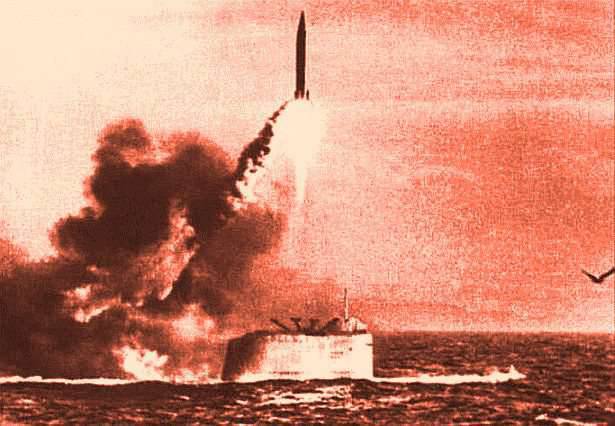
Work on the creation of missile weapons systems began in the USSR with the release of the Resolution of the USSR Council of Ministers on 13 in May 1946, from which, one can say, the time is counted on the organization of the rocket and then rocket-space domestic industry. Meanwhile, the ruling itself appeared not from scratch. Interest in a qualitatively new type of weapons arose long ago, and with the end of the war, ideas began to acquire real outlines, including thanks to the concrete acquaintance of Soviet specialists with German technologies.
The first, so-called organizational, step was taken by General L.М. Gaidukov, a member of the Military Council of the Guards mortar units. Having visited the end of the summer of 1945 with an inspection trip in Germany, the general familiarized himself with the work of our specialists in the surviving German rocket centers and concluded that the whole complex of works should be transferred to "domestic soil." Returning to Moscow, L.M. Gaidukov went to Stalin and reported on the progress in the study of rocket technologies in Germany and the need for their deployment in the USSR.
Stalin did not take a concrete decision, but authorized Gaidukov to personally familiarize the relevant commissars with this proposal. Negotiations L.M. Gaidukov with the People's Commissariat of the Aviation Industry (A.I. Shakhurin) and the People's Commissariat of Ammunition (V.Ya. Vannikov) did not produce results, but the People's Commissariat of Armaments (DF Ustinov) gave a preliminary, and then, after the trip of the First Deputy Commissar V.M. Ryabikov to Germany, and the final agreement to lead the work on the "rocket direction".
Another important result of the general's meeting with the leader was the release from the camps of many of the specialists and scientists necessary for the cause. Stalin personally imposed the appropriate resolution on a list prepared in advance by LM. Gaidukov together with Yu.A. Pobedonostsev, in which S.P. Korolev and V.P. Glushko. Both of them at the end of September 1945, have already been able to start work in Germany.
As we see, before the release of a well-known government document, a lot of organizational work has already been done. The May 1946 Resolution of the Year determined the circle of ministries, departments and enterprises that were responsible for creating purely military missiles, distributed responsibilities for the production of individual components, provided for the formation of leading industry industrial institutes, a missile testing ground for missiles, military institutes, determined the main customer from the Ministry of the Armed Forces - the Main Artillery Directorate (GAU), and also contained a number of other activities aimed x on the formation, as it is now called, a powerful military-industrial complex to create advanced technologies. It was entrusted to supervise the missile theme, the General Directorate headed by S.I. Vetoshkin, and to coordinate the work across the country, the State Committee "No. XXUMX" was formed (or, as it was sometimes called, "Special Committee No. 2").
Thanks to a well-thought-out organization of work, powerful state support and the enthusiasm of design teams, production workers and testers, which were usual in Soviet times, it was possible to create, develop and put into service P-7, P- 1, Р-2, to develop work on medium-range ballistic missiles Р-5М, to "advance" tactical missiles (PRP) Р-5 to the flight test stage.

Thus, by the time the rocket weapons sea-based (theme "Wave") - the sea component of the future triad of strategic nuclear forces (SNF) of the USSR - a certain cooperation has already developed between ministries, departments, enterprises and organizations of the rocket-making industry; there was experience in the production and operation of ground-based missile systems (RK) - there appeared cadres of scientific and engineering-technological profile and a certain experimental and production-technical base.
The theme "Wave" provided for the solution of the task in two stages:
1) conducting design and experimental work on the armament of submarines with long-range ballistic missiles;
2) based on (and based on) the first stage, develop the technical design of a large submarine with rocket armament.
Already during the first stage of work, the need for an integrated approach to the problem was recognized, i.e. Issues of a constructive, technological and operational nature during the creation of the submarine rocket carrier and the missile complex were linked into a single whole. It was then that the concept of “weapons system” became firmly established, the name of which usually included the submarine’s project number and the alphanumeric index of the missile system, the assignment of which was carried out according to the established procedure.
The creation of the first Soviet naval armament missile system "Submarine of the AV-611 - RK D-1" project, which was adopted by our Navy at the beginning of 1959, was the result of the first stage of work on the "Wave" theme.
The basis of the RK D-1 is the R-11FM submarine ballistic missile (SLBM) (where the FM index just means "naval model"). This SLBM was created on the basis of the ground-based R-11 tactical missile. The main reasons that prompted the designers and naval specialists to choose this rocket as a base, the small dimensions of the R-11 were, which made it real to be placed on a submarine, and the use of a high-boiling component (a derivative of nitric acid) as an oxidizer, which greatly simplified the operation of this rocket on a submarine, since it did not require carrying out various additional operations with fuel directly on the submarine after refueling the rocket.
The lead designer of the P-11 ballistic missile was V.P. Makeev, the future academician and creator of all sea-based strategic missile systems.
The lead designer of the SLBM P-11FM in the design bureau V.P. Makeev was appointed V.L. Kleiman, the future doctor of technical sciences, professor, one of the most talented and dedicated colleagues VP Makeev. It is worth noting that the R-11FM SLBM did not receive a “marine” alphanumeric index in the USA. In some publications on rocket technology, it seems that, considering the not very significant difference between it and the R-11 tactical missile, the R-11FM SLBM is designated as SS-1, i.e. the same alphanumeric index that was assigned in the United States OTP P-11.
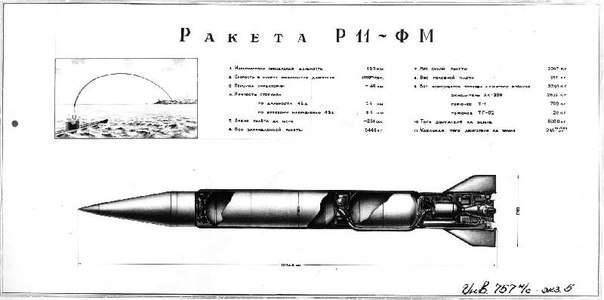
Structurally, the P-11 FM LCPM was a single-stage ballistic fuel-fired missile, the tanks for which the components were designed according to the carrier scheme. In order to increase the static stability of the rocket supplied with four stabilizers, which are placed in the tail section. On the flight path of the rocket was controlled by graphite rudders. The missile did not have any external differences from the Р-11 BR, its combat unit was inseparable.
Kerosene was used as fuel in the SLBM, which reduced the possibility of fire. And this is important in operating conditions on an underwater carrier. The refueling volume of fuel (by weight) was 3369 kg, of which 2261 kg is the oxidizer. The liquid single-chamber engine (LRE) with the displacing supply of the main fuel was made according to an open circuit, its thrust near the ground was about 9 tf. The engine was developed in KB, headed by A.M. Isaev - developer LRE for all domestic SLBMs.
The missile control system (SS) was inertial. Its basis was made up of gyroscopic devices installed in the instrument compartment of an SLBM: a "gyrovertikant" (GV), a "gyro-horizon" (GG) and a gyrointegrator of longitudinal accelerations. Using the first two instruments on board the rocket, an inertial coordinate system was created (taking into account the bearing on the target), with respect to which a controlled flight along the programmed trajectory to the target was made, including stabilization in flight relative to all three stabilization axes. Gyrointegrator served to implement the required on the instructions of the firing range of the rocket.
Another important component of the D-1 missile system for submarines was the launching table located in the missile shaft, raised by a special lift to the upper section of the mine (for loading SLBMs on a carrier boat and producing a launch from a surface position). Also, he could carry out a turn in azimuth around the central axis.

A starting device was mounted on the launch pad, the base of which was made up of two holding posts equipped with half grip. When the racks were in the reduced position, these half-claws formed a ring that covered the rocket. At this moment, the SLBM rested on racks with its stops located on the hull shell, thanks to which it was hung over the launch pad. After the engine was started and the rocket started moving, the supports holding the racks for a given functional were unfolded, and the rocket released from communication with the launch device started.
The first domestic missile carrier was a large, diesel, torpedo, submarine of the 611 project, specially converted by the B-611 project. The work was carried out by the Central Design Bureau of the Ministry of Food Industry under the guidance of his N.N. Isanina. The design was carried out with the participation and under the supervision of naval specialists - captain 2 of the rank B.F. Vasiliev and Captain 3 Rank N.P. Prokopenko. The technical project for re-equipment was approved at the beginning of autumn 1954 of the year, and the working drawings were sent to the construction plant (shipyard headed at the time by EP Egorov) in March of 1955. Dismantling work began in the fall of 1954. The builder of the submarine B-611 at the plant was appointed I.S. Bakhtin.
The technical project provided for the placement of two rocket mines in the bow of the fourth compartment, with appropriate instruments and other equipment. Most of the technical solutions were later used in the creation of serial AB-611 augers (according to the NATO classification "ZULU").
The development of a new weapon system was carried out in three technological stages. At the first stage - by launching rockets from a fixed ground stand, the effect of a gas jet emanating from a rocket engine nozzle was tested on nearby ship structures. On the second, missile launches were carried out from a special ground rocking stand, imitating the rolling motion of a submarine during a five-point wave of the sea. Under these conditions, the starting-table-launching device-rocket system was tested for durability and performance, the characteristics necessary for designing the starting device were determined, including the construction of an algorithm for selecting the starting moment (engine start).
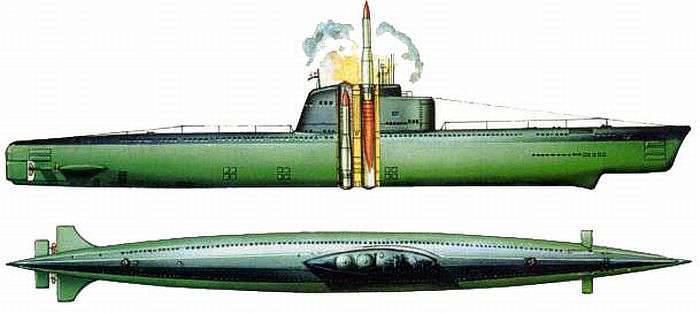
If for the first two stages it was enough to have a missile range (in the area of Stalingrad), then the third and final stage required real conditions. By this time, the submarine had been refurbished, and on September 16, the first launch of a ballistic missile from a submarine of the Soviet fleet was completed on 1955. The rocket era of our Navy began.
In total, 8 test launches were made, only one of them was unsuccessful: the launch was canceled automatically, and the rocket did not leave the ship. But a blessing in disguise - failure helped to work out the emergency missile release mode overboard. The tests were completed in October 1955, however, back in August, not waiting for their results, all the work on the R-11FMS SLBMs were transferred to the Ural Design Bureau, which was headed by V.P. Makeev. Before him was a difficult task - to complete all the experimental work, put the RC D-1 in the series and put it into service.
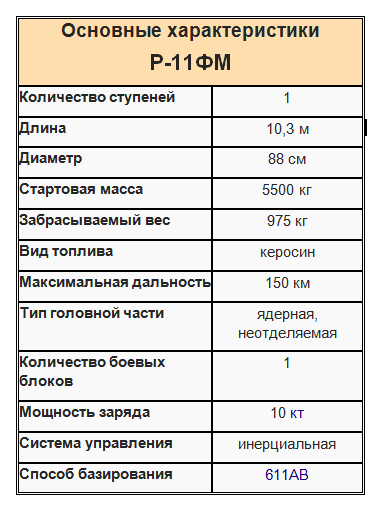
The first series of submarine missile-carriers consisted of the 5 submarine of the AB-611 project; four of them were still under construction and were refitted directly at the plant, and one was part of the Pacific Fleet, and its conversion was carried out at the Vladivostok Shipbuilding Plant. Meanwhile, the "refinement" of the new weapons system continued. Three missile launches were carried out under the conditions of a long-range cruise of the submarine B-67 in the fall of 1956, then the rocket was tested for explosion resistance, and in the spring of the 1958, joint operations began - the Navy and industry - flight tests (SLI) R-D-1 from the main submarine of the AV- project 611 B-73. Launches were carried out using the P-11FM SLBMs already supplied for mass production. The armament system of the submarine of the project AB-611 - RK D-1 was in service of the Navy from 1959 to 1967.
At the second stage of the theme "Wave", it was planned to create more advanced naval missiles. The tactical and technical requirements (TTZ) for the creation of a submarine, the draft of which received the 629 number (according to the NATO classification "Golf"), was issued in the spring of 1954. TsKB, headed N.N. Isanin. However, taking into account the capabilities of the American anti-submarine defense (300-400 km deep into the water area on its shores), a special government decree assigned the designers to make a rocket with a range of 400-600 km. She also intended to equip our first nuclear submarine (NPS) of the 658 project.
The fleet was to prepare new TTZs for the 629 submarine and the missile system, which was assigned the D-2 index. These tasks were approved and issued to industry at the very beginning of 1956 of the year, and in March a project of an underwater carrier was submitted to the Navy for consideration. However, it was not suitable for the release of working drawings, since there were no project materials for the D-2 complex. Then they decided to start the construction of a submarine with the D-1 complex, but with the subsequent re-equipment under the D-2 complex. In order to facilitate re-equipment, the maximum possible unification of the components of the missile complex was envisaged. So the first submarines of the 629 project with the D-1 appeared.
The D-2 missile system with the P-13 rocket, (according to the US classification - SS-N-4, NATO- "Sark"), the lead designer of which was LM. Miloslavsky, who received the Lenin Prize for it, largely repeated his predecessor in terms of the design scheme, composition, structure, construction and purpose of the onboard control system, and other main parts. Five-chamber engine - one central fixed and 4 steering. The central chamber with its turbopump assembly (TNA) and automation elements was the main unit (ON) of the engine, and the steering with its TNA and automation - the steering unit (RB) of the engine. Both blocks were open circuits.
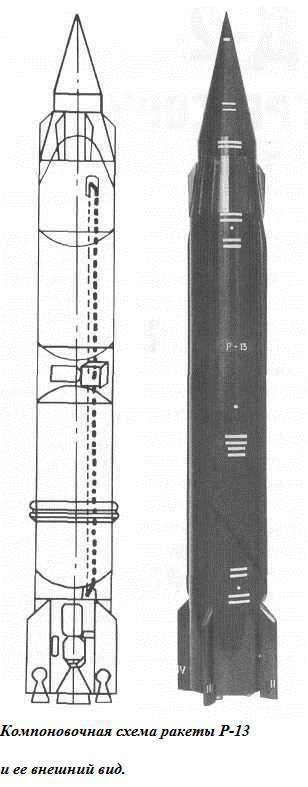
The use of swinging combustion chambers, as governing bodies, made it possible to abandon graphite rudders and get a certain weight and energy gain. In addition, it was also possible to use a two-stage shutdown (first OB, then RB) of the engine, thereby reducing the spread of the impulse and increasing the reliability of separating the warhead from the SLBM housing at all firing ranges.
The engine was about 26 TC. The supply system of the oxidizer and the fuel turbopump, charging tanks was carried out by two gas generators, which are part of the main and steering units of the engine. The first of them produced gas with an excess of fuel (to pressurize the fuel tank), the second - with an excess of oxidizer (to pressurize the oxidizer tank). This scheme made it possible to abandon the use of autonomous system of pressurization of tanks on board the rocket, provided a number of advantages.
The oxidizer tank was divided into two intermediate bottoms. The oxidizer was used first from the lower forecastle, which helped reduce the amount of overturning moment acting on the rocket in flight.
To increase the static stability of an SLBM in flight, an 4 stabilizer was placed in pairs in its tail section. The warhead of the missile was equipped with special ammunition and was made in the form of a cylindrical body, the front of which had the shape of a cone, with a conical rear skirt. To ensure the stabilization of the warhead in flight (after separation), plate-shaped “feathers” were installed on the conical skirt. The warhead was separated from the rocket by means of a powder pusher actuated by the onboard control system upon reaching a predetermined firing range. The launcher, which received the alphanumeric index CM-60, underwent significant processing. In an effort to maximally unify it and make it suitable for both the P-13 and P-11FM start-up, the TsKB specialists paid special attention to improving the reliability of the structure from the point of view of the safety of the missile during everyday and combat use. To do this, they used a more reliable scheme for fastening it with four grippers (the rocket was in a corset, as it were), introduced a number of locks that prevented any operation when the previous one was not carried out (with appropriate signaling), and so on.
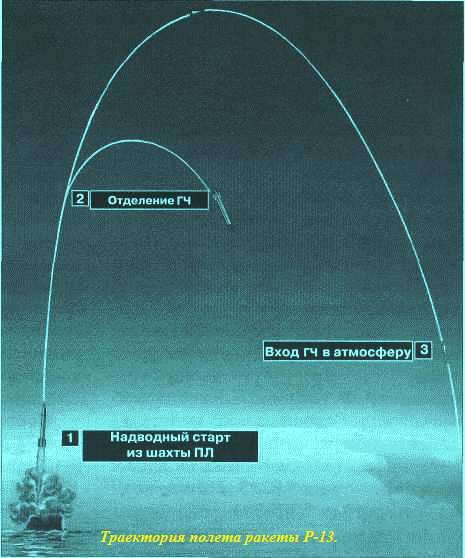
The next step in the implementation of the program was the laying of two submarines of the 629 project, which were to become the carriers of the D-2 missile system.
To be continued ...
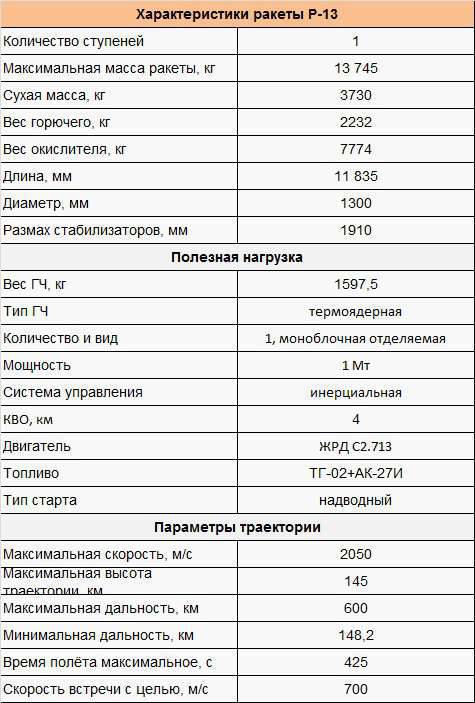
Sources:
Shirokorad A. Rocket technology of the Russian Navy // Equipment and weapons. 1997. No. 11-12. C.3-8.
Apanasenko V., Rukhadze R. Maritime nuclear missile weapons systems (past, present, future). M .: PIK VINITI Printing House, 2003. C. 4-21.
Apanasenko V., Rukhadze R. First-generation naval missile strategic systems // Sea collection. 1998. No.8. C. 38-46.
P. Kachur. D-2 complex: our response to the aggressor // Equipment and armament. 2005. No.7. C.14-17.
Zharkov V. Creation of the first submarines with ballistic missiles. // Gangut. 1998. No.14. C. 104-119.
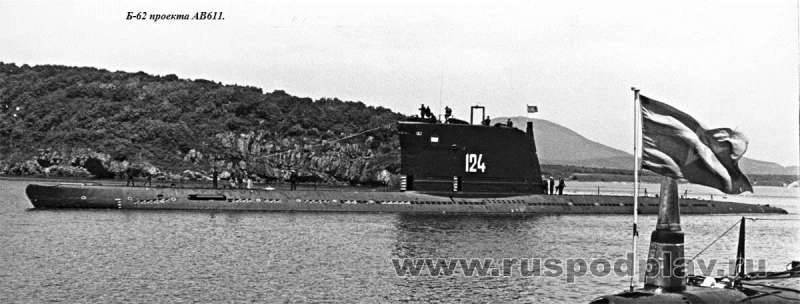
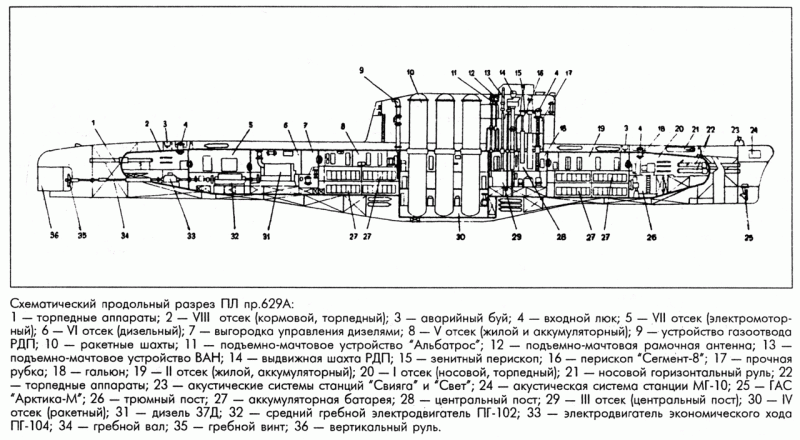
Information